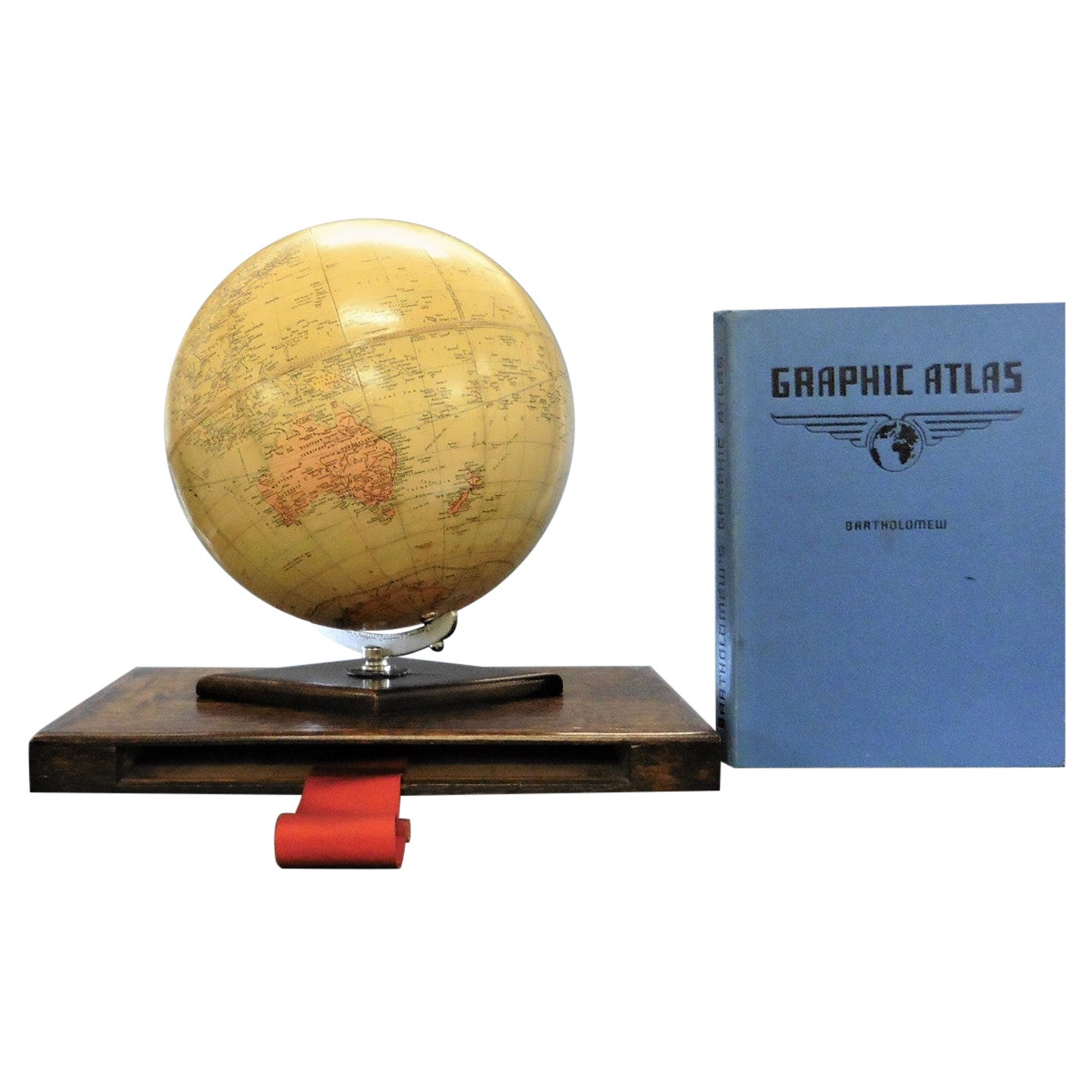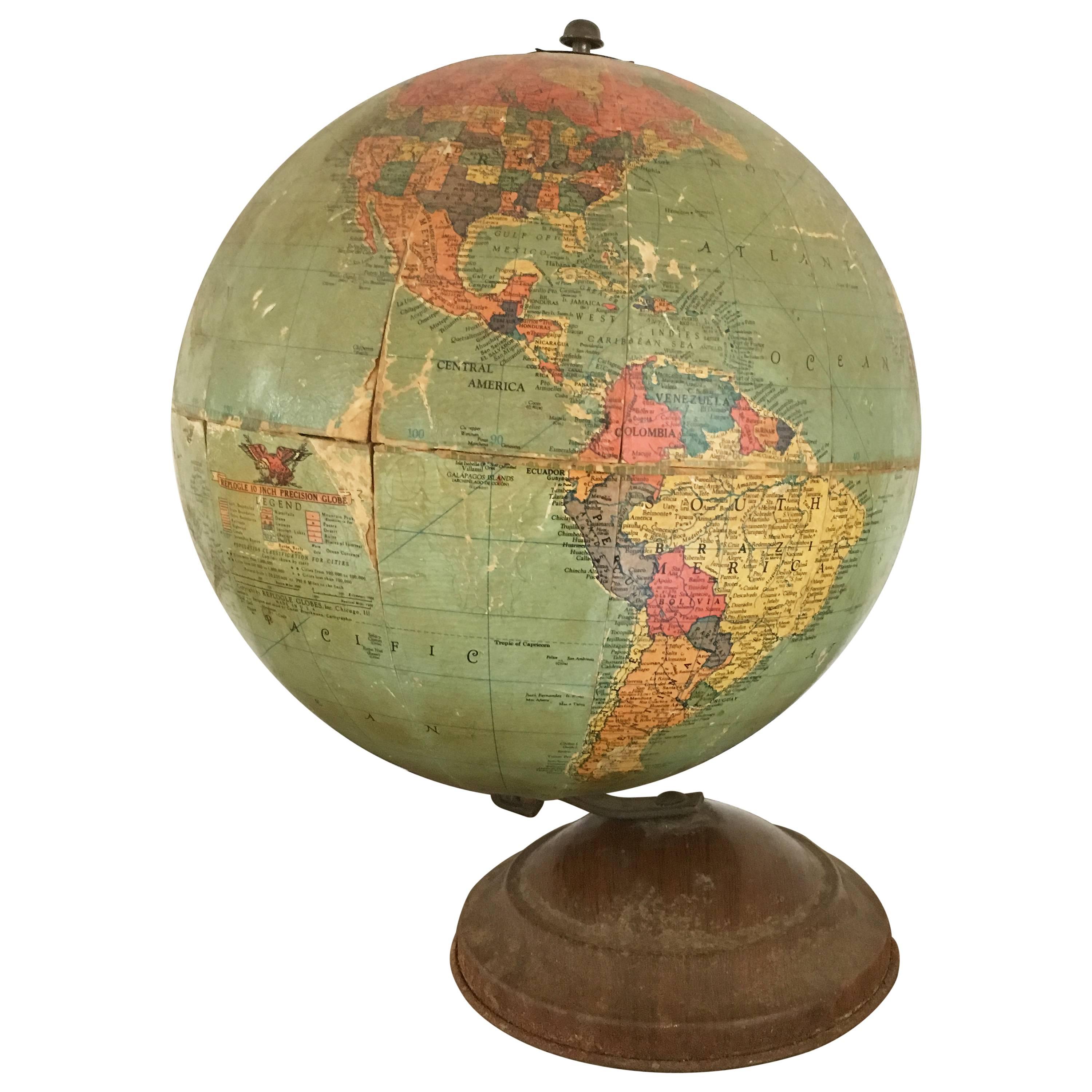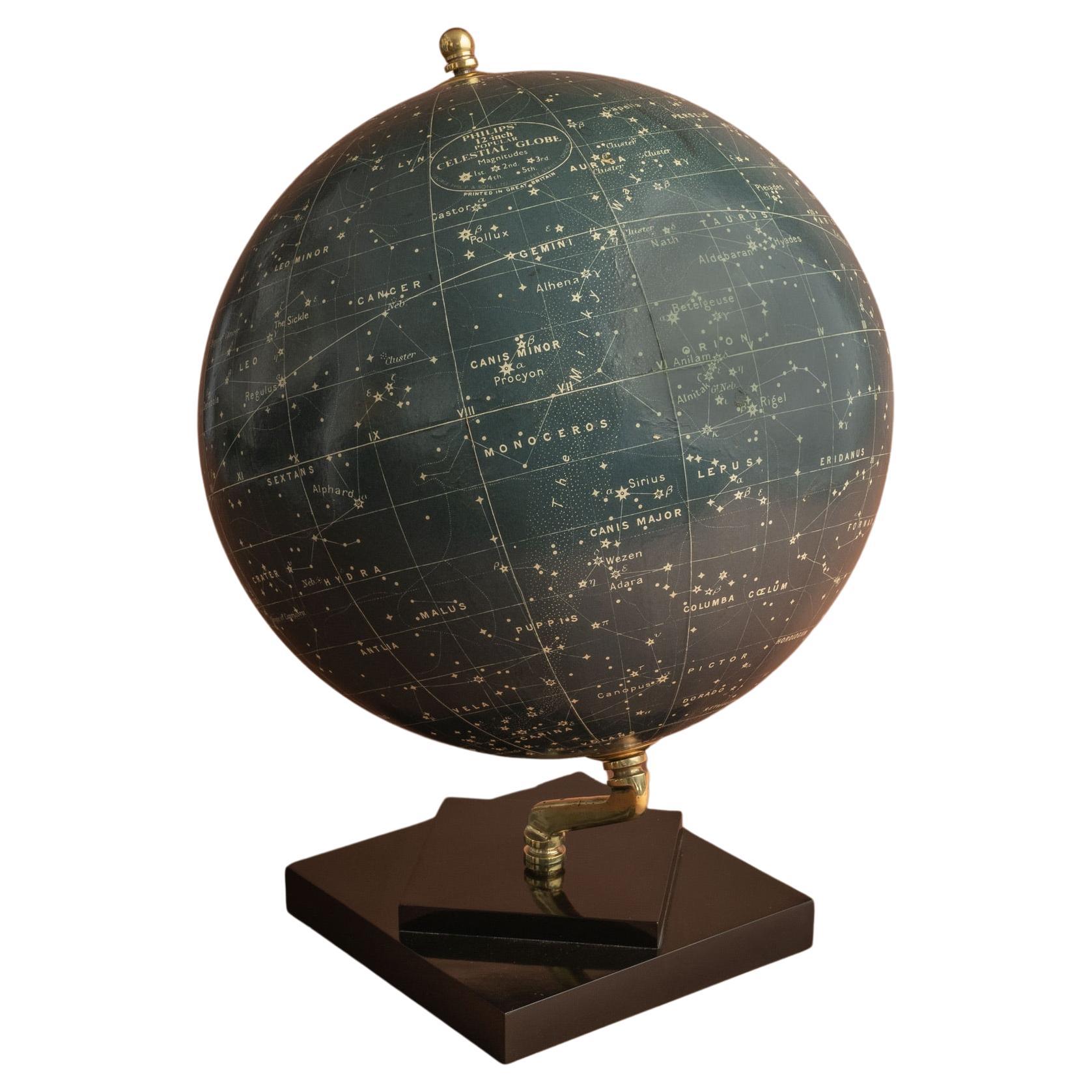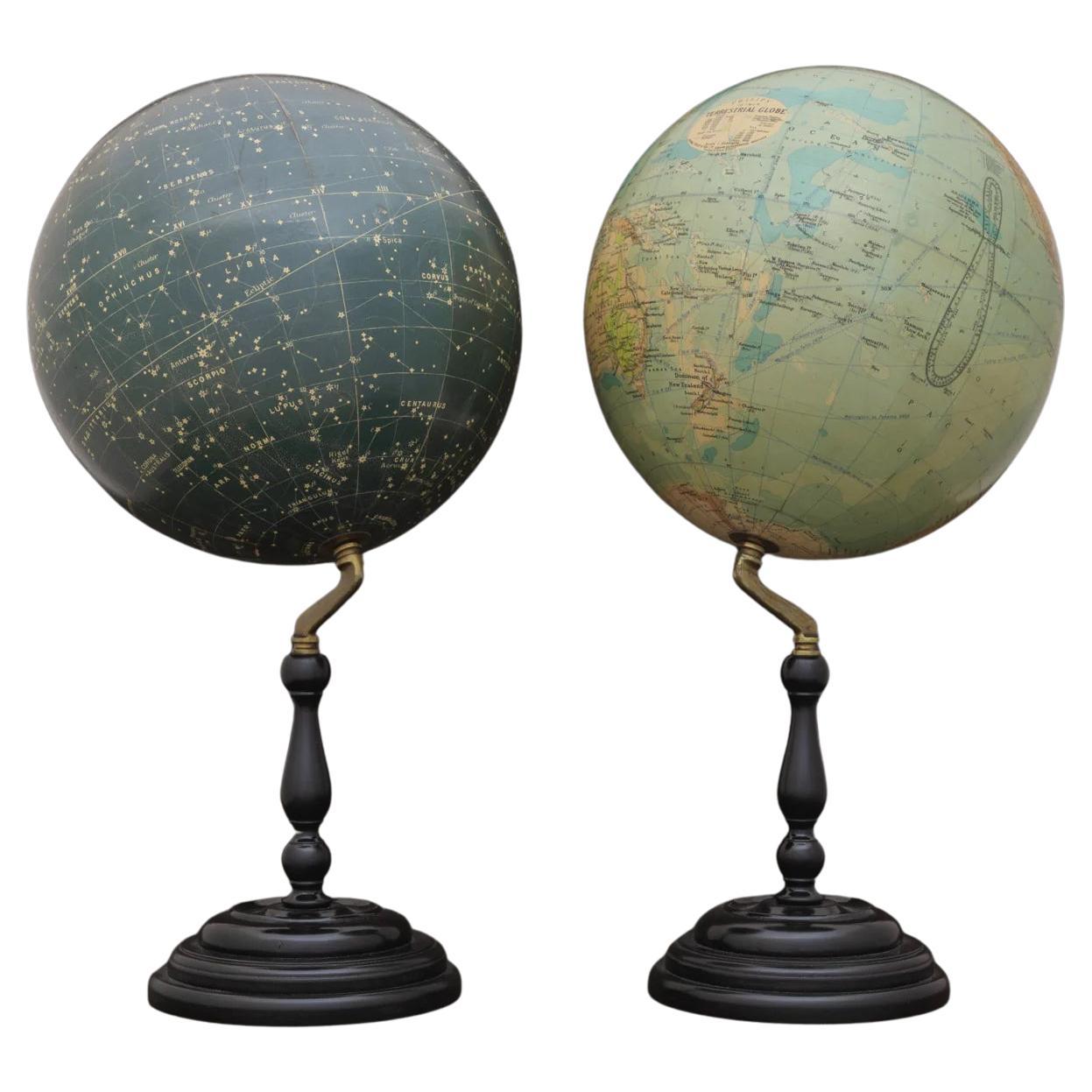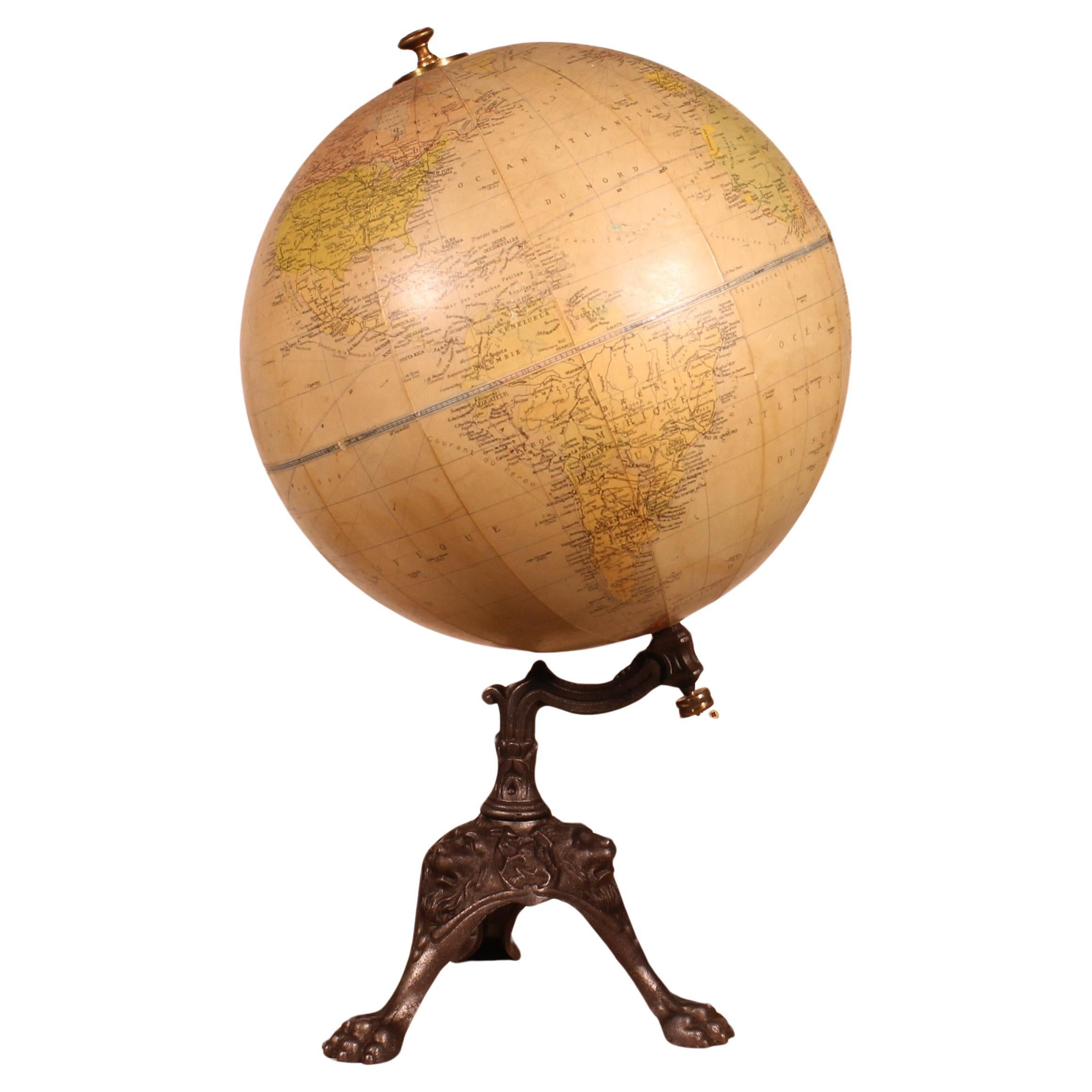Want more images or videos?
Request additional images or videos from the seller
1 of 17
Philips 14 Inch Globe, circa 1940
About the Item
A substantial 14 inch gesso terrestrial globe by Philips of London on brass inclined plain mount attached to original turned wooden based upright with axes secured at the top by a brass finial. Has Air Ministry stamp on the underside of the base. Circa 1940.
The globe is printed in several colours and comprises of twelve coated lithographic paper gores with polar calottes over a fourteen inch gesso covered sphere. The age of the globe has been determined by the named areas displayed and the political borders shown.
It shows all the continents and countries as they were at the time it was printed and also indicates all the principal shipping routes with distances in nautical miles and the principal railways. A cartouche is present that includes the title, maker's address, the scale (1:36,000000) and the colouring scheme used for the globe.
Dimensions: 35.5 cm/14 inches (Globe diameter) x 52 cm/20½ inches (Max. height on stand).
George Philip, (1800–1882) was a cartographer and map publisher. He founded George Philip & Sons in 1834 in Liverpool initially as a bookseller and stationer, but rapidly expanding to become a publisher of primarily maps, atlases and educational works. He had one son, also George (1823–1902), who was admitted to the business in 1848.
George senior was born in Huntly, Aberdeenshire and by 1819 he had become assistant to the Liverpool bookseller, William Grapel before going on to start his own business. He used cartographers (such as John Bartholomew the elder, August Petermann, and William Hughes) to produce maps on copper plates. Philip then had these printed and hand-coloured by his women tinters. The business expanded rapidly and by the time he produced his county maps of 1862 he was using machine coloured maps produced on power-driven lithographic presses.
Philips' production of globes in the 19th century was mainly limited to associations with other British globe makers, including Smith & Sons, London, but in 1902 Philip ventured into the production of globes as a manufacturer, facilitated by the firm's establishment of the London Geographical Institute, a large factory for map, atlas, and globe production. Globes from this era are generally constructed by forming a sphere made either of card or fibreboard covered by gesso (plaster) to ensure smoothness.
The sphere was then overlaid with a map printed on long, thin elliptical strips of paper (known as gores) that narrow to a point at the North and South Poles.
Over the years, Philip acquired the production lines of other British globe makers including Malby, Betts, Smith and Johnston. The firm also supplied atlases and textbooks overseas starting with an atlas for Australian schools in 1865 and for New Zealand in 1869. The demand from board schools, established after 1870, enabled further expansion in the market for globes, atlases and wall maps.
Bentleys are Members of LAPADA, the London and Provincial Antique Dealers Association.
- Creator:Philips (Maker)
- Dimensions:Height: 20.5 in (52.07 cm)Diameter: 14 in (35.56 cm)
- Materials and Techniques:
- Place of Origin:
- Period:
- Date of Manufacture:circa 1940
- Condition:Wear consistent with age and use.
- Seller Location:London, GB
- Reference Number:1stDibs: LU960036817692
About the Seller
5.0
Vetted Seller
These experienced sellers undergo a comprehensive evaluation by our team of in-house experts.
Established in 1989
1stDibs seller since 2013
64 sales on 1stDibs
Associations
LAPADA - The Association of Arts & Antiques Dealers
- ShippingRetrieving quote...Ships From: London, United Kingdom
- Return PolicyThis item cannot be returned.
More From This SellerView All
- Philips' Celestial Globe, circa 1935By George Philip & SonLocated in London, GBA stylish celestial globe on a brass inclined plain mount attached to original square bakelite base and secured at the top by a brass acorn finial. By George Philip and Son; circa 1935...Category
Vintage 1930s British Globes
MaterialsBrass
- Pair of Philip & Son Globes, circa 1946By George Philip & SonLocated in London, GBA wonderful set of Terrestrial and Celestial 12 inch globes by George Philip and Son. Presented on brass inclined plain mounts attached to original turned ebonized wooden bases and uprights with axes secured at the top by brass acorn finials. Unusually, the terrestrial globe has a copyright date shown under the cartouche, 1946. The celestial globe is printed in beige against a dark blue background and shows the constellations and many named stars. Solid lines connect the stars within constellations rather than illustrating them as mythological and other figures.? A cartouche is present that includes the title and maker's address. When looking at the stars from Earth the viewpoint is effectively inside a celestial sphere. The surface of a celestial globe shows the star field as a projection viewed from the outside and is therefore reversed, with the constellations appearing as their mirror images. The terrestrial globe is printed in several colours and comprises of twelve coated lithographic paper gores with polar calottes over a twelve inch card sphere. The age of the globe has been confirmed by the political borders and named cities displayed. The globe is nicely detailed and has a grid network of parallels and meridians. It shows all the continents and countries as they were at the time it was printed and also indicates all the principal steamship routes with distances in nautical miles. The globe also has a printed Analemma - a diagram showing the declination of the Sun for every day in the year and the equation of time. The Analemma therefore shows the position of the Sun in the sky as seen from a fixed location on Earth at the same mean solar time, as the sun's position varies over the course of a year. A cartouche is present that includes the title and maker's address. Dimensions of each globe: 30.5 cm/12 inches (diameter) x 59 cm/23 1/4 inches (max height). George Philip, (1800–1882) was a cartographer and map publisher. He founded George Philip & Sons in 1834 in Liverpool primarily as a bookseller and stationer, but rapidly expanding to become a publisher of primarily maps, atlases and educational works. He had one son, also George (1823–1902), who was admitted to the business in 1848. George senior was born in Huntly, Aberdeenshire and by 1819 he had become assistant to the Liverpool bookseller, William Grapel before going on to start his own business. He used cartographers (such as John Bartholomew the elder, August Petermann, and William Hughes) to produce maps on copper plates. Philip then had these printed and hand-coloured by his women tinters. The business expanded rapidly and by the time he produced his county maps of 1862 he was using machine...Category
Vintage 1940s British Globes
MaterialsBrass
- Chalons Steamer Trunk, circa 1915Located in London, GBA wonderful trunk by the French Grand Magasin, Chalons, of Alexandria Egypt. With brass fittings, and original interior lining and key, circa 1915. Dimens...Category
Vintage 1910s French Trunks and Luggage
MaterialsBrass
- Goyard Shoe Trunk, Circa 1900By GoyardLocated in London, GBA splendid shoe trunk by Goyard with chevron pattern canvas covering, leather handles & trim, and polished brass fittings; circa 1900. The interior has the ...Category
Antique Early 1900s French Trunks and Luggage
MaterialsBrass
- Motoring Picnic Case, circa 1910Located in London, GBImpressive six person motoring picnic case; circa 1910. The collection comprises six enamelled tin plates, six ceramic cups with matching saucers and...Category
Vintage 1910s European Trunks and Luggage
MaterialsMetal, Brass
- Goyard Wardrobe Trunk, circa 1920By GoyardLocated in London, GBAn unusual Goyard wardrobe trunk with original chevron pattern canvas covering, brass fittings and original cotton lined interior providing hanging space. Circa 1920. The proporti...Category
Vintage 1920s French Trunks and Luggage
MaterialsBrass
You May Also Like
- Philips 10 Inch Challenge GlobeLocated in Norwich, GBPhilips 10 inch challenge globe Philips 10 inch globe standing on a raised oak chamfered base and resting on a rectangular oak base incorporating a ribbon p...Category
Vintage 1950s English Globes
MaterialsOak
- Vintage Replogle 10-Inch Globe, circa 1940By Replogle GlobesLocated in Napa, CAGorgeous antique Replogle globe, handmade, circa 1940, on metal base. Incredible patina; please review images and inquire for additional con...Category
Vintage 1940s American Globes
MaterialsMetal
- Terrestrial Globe By PhilipsLocated in Brussels, BrusselsVery beautiful Terrestrial Globe made by Philips Londre based on the maps of Taride Paris Boulevard Saint Germain The Terrestrial Globe has a very beautiful cast iron base decorated...Category
20th Century British Napoleon III Globes
MaterialsPaper
- 1920s Rand McNally 8 Inch Terrestrial GlobeLocated in Tarrytown, NY1920s Rand McNally 8 inch Terrestrial Globe.Category
Vintage 1920s Globes
MaterialsPaper
- Rand McNally Twelve Inch Terrestrial GlobeBy Rand McNally & Co.Located in Savannah, GAA Rand, McNally & Co. twelve inch terrestrial globe on cast iron base, first quarter 20th century. 15 inches wide by 12 inches deep by 23 inches tallCategory
Early 20th Century American Art Deco Globes
MaterialsIron
- A Cary’s 15 inch terrestrial globe 1849By George & John CaryLocated in Lymington, HampshireA Cary’s 15 inch terrestrial globe, 1849, set in a mahogany stand with a turned baluster support on three splayed scroll legs centred on a compass rose, the cartouche stating ‘Cary’s...Category
Antique 19th Century English Globes
MaterialsMahogany
